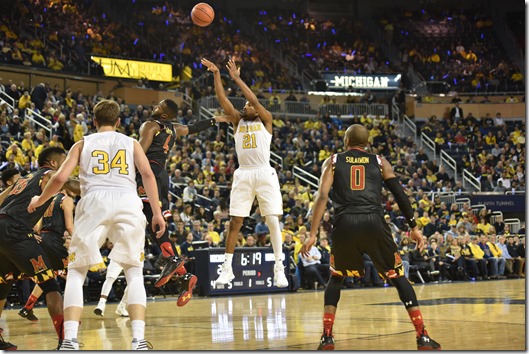2015-16 maryland
Bryan Fuller
It’s hard to believe, but John Beilein’s now in his ninth season at Michigan. About a week and a half ago, he coached his 300th game for the Maize and Blue. After a coach has been around for a certain amount of time, he essentially becomes a known quantity: his offensive philosophies, defensive strategies, substitution patterns, recruiting priorities, and player development trends are all well-known among Michigan fans, and at this point, there’s little mystery about John Beilein or his methods.
In the wake of two embarrassing blowout losses to hated rivals, there was predictable bellyaching about Beilein’s level of job security – some fans even went as far as to call for his firing (while evidently forgetting the Ellerbe-Amaker purgatory that Beilein pulled Michigan out of in the first place). To be sure, it’s easy for people to harp on Beilein’s perceived blind spots and, to be sure, some of those complaints are valid. The reluctance to play guys in foul trouble has surely cost Michigan games over the years. Empirically, we’ve discovered that he manages to develop average defenses at best, and usually they’re far more mediocre than average. Sometimes it seems as if he struggles to accommodate players who don’t have skill sets tailor-made for his system. Gripes about his recruiting strategy and/or the outcome of his recruiting classes have varying levels of credibility.
Still, it’s important to remember Beilein’s strengths. He was well ahead of his time with his insistence on spacing, shooting, and using a non-traditional four in his signature four-out motion offense. There are several notable examples of his players vastly overachieving relative to what their recruiting rankings would project. He adapted to the unprecedented level of talent on his teams by implementing more pick-and-roll action into his offense – and indeed, the trend of his guards developing their passing ability in those sets can surely be attributed to coaching. He coached the best offense in the country in two separate years. He’s won two Big Ten titles – including an outright title in a year in which #2 finished three games behind Michigan in college basketball’s toughest contest. He was once a few possessions from winning a national title. He was once a few possessions from reaching another Final Four.
All of that is to say: you’re crazy if you legitimately want Michigan to replace John Beilein. The grass isn’t always greener on the other side, and it’s pretty green here already.
* * *
More or less, this has been a pretty frustrating season (and I’m convinced that the hideous shorts play a not-insignificant part in that). With the notable exception of wins over Maryland and Purdue – more on those in a second – Michigan has won as the favorite and lost as the underdog, and more than a few of those losses have been complete annihilations. Spike Albrecht’s senior season died before it could even begin. Caris LeVert missed over half of Big Ten play with an injury (but he’s back! Woo!). The reality has probably been better than the discourse would indicate: Michigan’s sitting in fourth in the Big Ten, should be safely in the NCAA Tournament barring an epic meltdown, and, critically, still has plenty of room to improve – especially if LeVert makes it back to his phenomenal early-season form.
Anyways, back to those wins over Maryland and Purdue. Those two wins are the linchpin of Michigan’s NCAA Tournament resume: without them, Michigan would be in the unenviable position of talented low-major programs that put up a gaudy win-loss record before losing in their conference tournament – without wins over good opponents, those teams typically find themselves in the NIT.
What do Maryland and Purdue have in common? Per KenPom’s “effective height” metric (which adjusts each individual’s height based on how many minutes they play), they are the two tallest high-major teams in the country. A common criticism of John Beilein teams is that they are ill-equipped to deal with teams with size: juxtaposed against the construct of the big, burly, physical Big Ten, Beilein’s teams – which prize skill and shooting – often match up poorly, in theory.
[After the JUMP, small-ball defeats bully-ball]

49